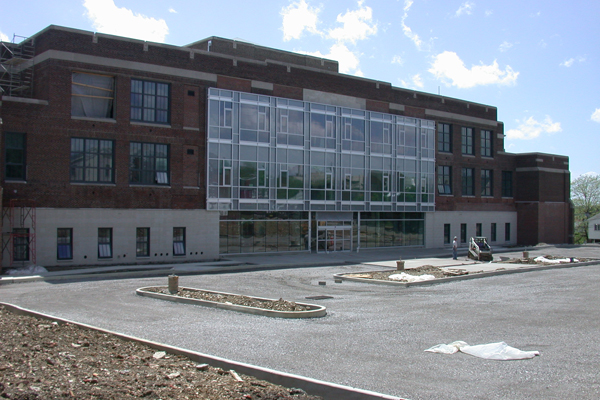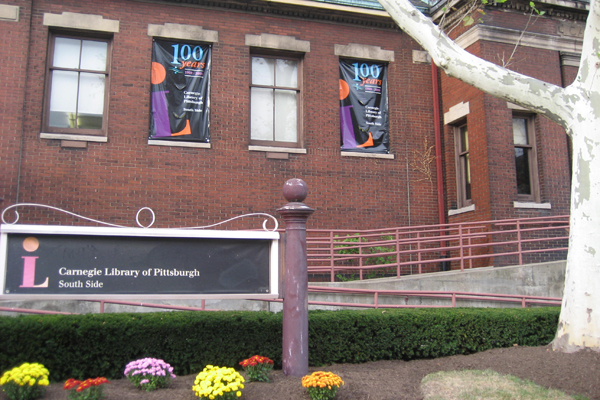
Category Archive: Neighborhood Development
-
Exhibit Celebrates the Many Styles of Homes in Beaver
Saturday, November 06, 2010By Marylynne Pitz, Pittsburgh Post-Gazette
A model replica of the Agnew-Anderson House, built in 1808, is among the exhibits in "Bricks, Mortar and Charm," an exhibition at the Beaver Area Heritage Museum. Bob Donaldson / Post-Gazette
BEAVER — Since 1802, this town 35 miles northwest of Pittsburgh has reflected the aspirations of the bankers, doctors, teachers, lawyers and politicians who inhabit its quaint streets and River Road, a lovely stretch of beautiful homes that overlooks the Ohio River.
Now, this community’s architectural aspirations are on view in a concise exhibition called “Two Hundred Years of Bricks, Mortar & Charm” at the Beaver Area Heritage Museum in downtown Beaver.
Local historians believe that a house built in 1805 and still standing at River Road and Market Street is the town’s oldest structure. Part of the home’s front section was built with hand-hewn logs that are still visible in the basement. The logs may have been salvaged from Fort McIntosh, a Revolutionary War structure built in 1778.
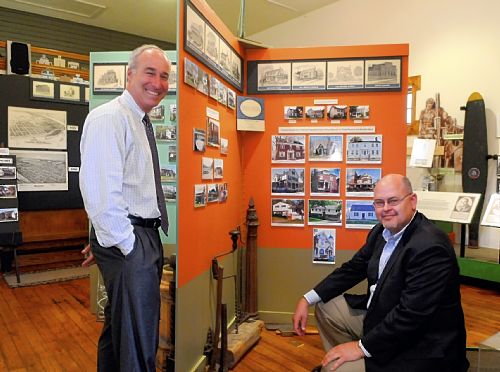
Edwards McLaughlin, left, and Mark Miner of the Beaver Area Heritage Museum take a look at "Bricks, Mortar and Charm," an exhibition that documents the architecture of Beaver. Bob Donaldson / Post-Gazette
Edwards McLaughlin, chairman of the museum’s board of trustees, spent weeks photographing homes all over Beaver for the exhibition, which examines the evolution of design styles in 50-year periods. His volunteer work correlates to his day job because he’s a partner in the real estate firm Bovard Anderson and a fourth-generation owner of the business.
With its 19th-century-style street lights and restored storefronts, Beaver retains its Victorian-era look. So it’s no surprise that from 1850 to 1900, plenty of Colonial Revival, Queen Anne and other Victorian-period homes were built. There’s also a smattering of Italianate, Gothic Revival and Romanesque homes.
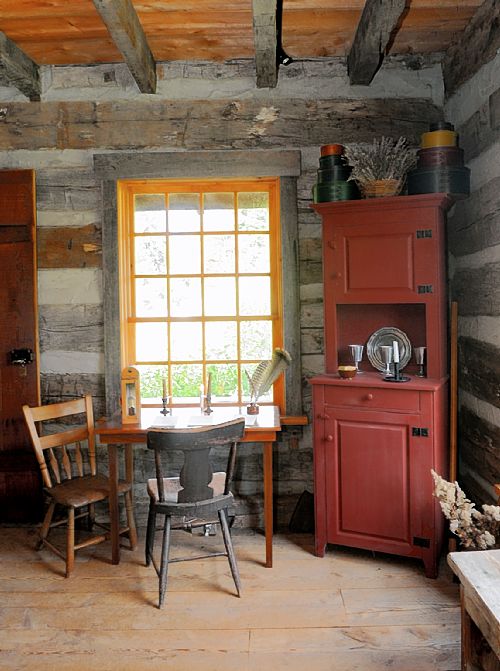
A replica log cabin is part of the Beaver Area Heritage Museum's permanent exhibit. Bob Donaldson / Post-Gazette
Surveyor Daniel Leet laid out Beaver, creating four squares in the center of town and four at its edge. Each one is named for a prominent resident or military leader. Agnew Square, for example, is named for Daniel Agnew, who was chief justice of the Pennsylvania Supreme Court. At Third Street and College Avenue, an exact replica of the clock tower that adorned the 1877 courthouse stands on the southeast corner.
A new century dawned and tastes changed between 1900 and 1950. As a result, Beaver has examples of English Tudor, Craftsman bungalows and Art Deco designs. There are even examples of Prairie-style homes, a Frank Lloyd Wright design ideal that emphasizes an open floor plan, horizontal lines, shallow roofs with broad overhangs and banks of casement windows with art glass.
The exhibition features an excellent model of Beaver’s 1877 courthouse plus a replica of the Agnew Anderson House. Both were made by Robert A. Smith.
Mr. McLaughlin is just one of several hundred volunteers who combined their collective, considerable elbow grease to transform a former Pennsylvania & Lake Erie Railroad freight house into the Beaver Area Heritage Museum 12 years ago. The building was a shambles with holes in the ceiling, thick grime on the floors and a basement packed with old dust.
Now, the museum sparkles. There’s a permanent exhibition about the Beaver region, an outdoor vegetable and herb garden with native plants and an 1802 log house that’s a replica of a frontier home.
Mildred “Midge” Sefton, a retired home economics teacher, oversees the volunteers, who meet regularly on Thursday mornings in the basement to accession, catalog and log onto a database each artifact and document that is donated to the museum. Judy Reiners of Beaver recently finished compiling family documents that belonged to Adolf Mulheim, proprietor of a wallpaper and carpet store from around 1880 to the 1930s.
-
Counties Seek Funds to Refurbish Mon River Ferry
Friday, November 05, 2010Pittsburgh Post-GazetteThe Washington County Commissioners have approved a $971,000 federal grant application to refurbish the Fredericktown Ferry, better known as Fred, which links two tiny towns separated by the Monongahela River.
Fayette County officials signed off on the application last year.
The Port of Pittsburgh Commission recommended repairing the cable driven ferry that shuttles vehicles and passengers across 800 feet of the river between Fredericktown, Washington County, and LaBelle in Fayette County.
The three- to four-minute trip saves motorists from driving about 16 miles to the nearest bridge.
The 60-foot-steel boat can carry six vehicles per trip, and transports about 500 each day.
-
Setback Won’t Deter Move of Historic House
Friday, November 05, 2010By Len Barcousky, Pittsburgh Post-GazettePaul Orange hasn’t given up hope that he will be able to buy and relocate the historic William Smith House in Mercersburg, despite a setback Thursday.
The house is on land owned by the MMP&W Volunteer Fire Co., which acquired the property in 2009 with plans to expand its aging facilities.
The board that oversees the regional fire company opened bids on Thursday for demolishing the 260-year-old structure but did not consider a proposal from Dr. Orange to move it.
Contacted after the meeting, Dr. Orange said he was advised that his offer to pay the fire company $100 for the building, rather than charge for tearing it down, had not been submitted in the right form.
The fire board, however, took no action on the demolition bids it received during its 15-minute meeting. That decision gives him hope that he still can reach an agreement to preserve the house, he said.
Joel Bradnick, a spokesman for the fire board, said the five bids would be forwarded to the fire company’s engineer for evaluation. He described Dr. Orange’s offer as a nonbinding “one-line memo.”
The low bid for demolition was $18,000.
“But why pay $18,000 to knock something down when you have someone willing to give them money to take it away,” Dr. Orange said.
The fire station and the Smith House are next to each other on Mercersburg’s Main Street.
If he is able to reach an agreement to move the house — either with the fire company or with the firm chosen to do the demolition — the next likely step would be to acquire a new location nearby. One possibility is a lot on the other side of Main Street, the site of a closed gas station.
Relocation and land acquisition could cost him as much as $100,000.
The Smith House was built in the 1750s. Constructed as a one-story cottage, it was greatly modified in the 19th and 20th centuries with the addition of a second story and porches.
News that the Smith House might be demolished attracted the interest of a museum in Northern Ireland. The Ulster American Folk Park has been developing plans to rescue the 18th-century first floor of the structure and move it to Europe. There it would become part of a collection of buildings with ties to Scotch-Irish immigration history. Several structures at the outdoor museum were moved from their original sites in southwestern Pennsylvania.
Worries about demolition also resulted in the formation of a small citizens group called the Committee to Save the William Smith House. Committee members have thrown their support behind Dr. Orange’s efforts to move the building.
“I hope we all can come together in a goodwill effort to restore this important piece of history,” said Karen Ramsburg, president of the Smith House committee. “This is America’s house, and I think it could become a real tourism magnet near the Interstate 81 corridor.”
Mercersburg is about 150 miles southeast of Pittsburgh. It is about 10 miles west of the Greencastle exit of I-81.
William Smith, an 18th-century businessman and local magistrate, was one of the leaders of what historians describe as the earliest organized opposition to British rule of its American colonies.
His home was a meeting place in 1765 for mostly Scotch-Irish settlers who organized themselves into armed bands. They formed a local militia after concluding that neither the Quaker-dominated colonial government in Philadelphia nor British officials in London were able to protect them from Indian raids.
William Smith’s brother-in-law, James Smith, was the leader of a group of settlers known as the “Black Boys,” who disguised themselves with paint and Indian clothes. Armed and angry, the Black Boys stopped pack trains traveling from Philadelphia to Fort Pitt that they believed were carrying weapons and ammunition that would end up in the hands of their Native American enemies.
After the British sent troops to nearby Fort Loudon to protect the traders and arrest the Black Boys, the soldiers twice found themselves besieged by the frontier militia.
The shots fired in 1765, 10 years before the Battles of Lexington and Concord, could be called the opening shots of the American Revolution, supporters of the Smith House say.
Dr. Orange describes himself as a history buff. A Westmoreland County native, he is a graduate of Greensburg Central Catholic High School and Saint Vincent College. He has a family medical practice on Route 30, east of Chambersburg.
-
$22 Million Sustainable Reuse Project Transforms Former Mt. Washington School
Wednesday, November 03, 2010
Pop City Media
Abandoned for over 25 years and once the location of Mt. Washington’s highest crime rates, the former South Hills High School building at 101 Ruth Street is being reused and transformed into a 160,000 square-foot sustainable and affordable mixed-use community asset as the South Hills Retirement Residence.
“The building fell into terrible disrepair,” says Laura Nettleton, an architect at Thoughtful Balance Inc., who co-designed the building with Rothschild Doyno Collaborative. “There was a lot of water damage and the neighbors were dismayed when their property values fell.”
Working with developers Rodriguez Associates and Sota Construction, the architects installed 106 1- and 2-bedroom apartments for seniors, 22 of which are market rate and 84 that are age and income restricted. The ground floor contains a 7,500 square-foot space that will become a YMCA community fitness center and a 4,500 square-foot space that will become a daycare center.
The architects and developer expect to receive LEED Gold certification for the project, which contains sustainable features like a full-building spray foam insulation and an energy efficient mechanical system. The project team was awarded a grant for alternative energy systems, and there is a 27 kilowatt photovoltaic array on the roof and a gas fueled co-generation plant in the penthouse that generates power on site.
Funding for the $22 million project came from multiple sources, including the Pennsylvania Housing and Finance Agency, the URA, and Allegheny County.
Writer: John Farley
Source: Lura Nettleton, Thoughtful BalanceImage courtesy Thoughtful Balance
-
Carnegie Library Approves Plans to Renovate Historic South Side Branch
Wednesday, November 03, 2010
Pop City Media
The Carnegie Library of Pittsburgh Board of Trustees has unanimously agreed to make plans to renovate the South Side branch a top priority with funding to come from the Libraries for Life capital campaign that has set aside $2.7 million for renovating the aging building.
“The South Side does not have air conditioning and it’s a little over 100 years old. It’s not compliant with the guidelines of the Americans with Disabilities Act,” explains Suzanne Thinnes, communications manager for the Carnegie Library. “We find that when libraries are renovated they bring a new excitement to the community. More people discover the library and we see our circulation and account numbers go up.”
While the renovation process is in its early stages and an exact date for the project’s completion is currently ambiguous, a community meeting is scheduled at the South Side branch on November 17 at 6 p.m. to hear from the community about what they’d like to see preserved and changed about the library. Karen Loysen of Loysen + Kreuthmeier is the architect for the project and the upcoming meeting marks the start of a public dialogue that will create a vision for the library hoping to satisfy as many people as possible.
Writer: John Farley
Source: Suzanne Thinnes, Carnegie Library of Pittsburgh -
Condemned Larimer Building Wins Reprieve
By Adam Brandolph
PITTSBURGH TRIBUNE-REVIEW
Tuesday, November 2, 2010An Allegheny County judge put a temporary halt on the city’s plan to demolish a condemned property in Larimer after a Sharpsburg man said he wants to restore it.
John Cobb plans to rehabilitate a 110-year-old building at 16 Shetland St. to use as an investment property, said his attorney, Matthew L. Kurzweg. Cobb, who applied for permits to reverse the condemnation after the judge’s decision on Friday, declined comment.
“From my understanding, the building is pretty structurally sound,” Kurzweg said Monday.
Common Pleas Judge Robert Colville said the city could demolish the building after Feb. 1 if Cobb fails to show progress on the rehabilitation.
Pittsburgh building inspection officials said the property is in bad condition but don’t believe the city will appeal the judge’s decision. City Solicitor Dan Regan could not be reached for comment.
Sherry Hickson, 72, a longtime Larimer resident, said the building needs to go.
“If it’s in bad condition, it could pose a threat to everyone around it,” Hickson said.
Neighbor Robert S. Brown said he would like to see the building restored.
“There are so many places where every building is torn down, and it looks ugly,” Brown said. “If this guy wants to try to restore it, they should let him.”
The building is one of many slated for demolition. Mayor Luke Ravenstahl budgeted $3.04 million to level condemned buildings this year, including $2.19 million in city money and $850,000 in federal dollars.
-
Physician Offers to Move Historic House in Mercersburg
Tuesday, November 02, 2010By Len Barcousky, Pittsburgh Post-Gazette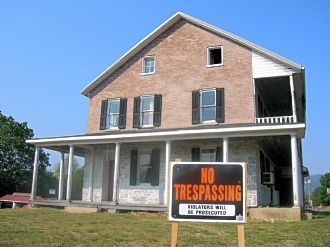
The Smith House is located next to the MMP&W Volunteer Fire Co. The board that oversees the fire company says it needs the land to expand its aging facilities. Len Barcousky/Post-Gazette
A Franklin County doctor has offered to relocate the historic Justice William Smith House in Mercersburg.
“I have a love of history,” Paul Orange said Monday.
He was reluctant to provide too many details of his proposal, but he said he was prepared to cover the costs of moving the two-story structure to a new location. Those expenses, including the cost of acquiring a suitable alternate property, could run as high as $100,000.
Dr. Orange has a family practice along Route 30 in Fayetteville, which is between Chambersburg and Gettysburg. He said he moved to the area in part because of its ties to important events during the Civil War. He is a graduate of Greensburg Central Catholic High School and St. Vincent College. After graduating from medical school at the American University of the Caribbean, he did his residency at Latrobe Hospital.
The Smith House is located next to the MMP&W Volunteer Fire Co. on Mercersburg’s Main Street. The board that oversees the fire company says it needs the land on which the house sits to expand its aging facilities, and it has sought bids for demolition of the building. Its initials stand for Mercersburg, Montgomery, Peters and Warren, which are the communities it serves.
The bids are to be opened Thursday, but the fire company has not said when it will award the contract.
Dr. Orange said he has submitted an offer to move the structure, which would save the fire company the expense of tearing it down.
His proposal has gained the support of a small citizens group, the Committee to Save the William Smith House, which has sought to head off any demolition plans.
“This is an amazing turn just when I thought we were dead in the water,” said Karen Ramsburg, who heads the Smith House committee. “I’m surprised and excited.”
One potential new home for the 18th-century building is the nearby site of a former gas station owned by the First National Bank of Mercersburg.
“The best-case scenario would be to keep the house in its current location,” Ms. Ramsburg said. “Moving it across the street would be the next best thing.”
In 1765, the Smith House was the meeting place for mainly Scotch-Irish settlers who organized themselves into a militia for defense against Indian raids.
Their efforts morphed into attacks on British supply trains and a siege of a nearby British military base called Fort Loudoun. Those early instances of armed resistance took place eight years before the Boston Tea Party and 10 years before the battles of Lexington and Concord.
“It could be said that people in this house provided the spark for the American Revolution,” Dr. Orange said.
Architectural details and property records indicate that the house was built between 1751 and 1759, which includes a portion of the French and Indian War. Porches and a second story were added during the 19th and 20th centuries.
The structure’s connection to the region’s early Scotch-Irish settlers has drawn the attention of an outdoor museum in Northern Ireland.
The Ulster American Folk Park has been working on plans to take apart the 18th-century “historic core” of the stone structure, ship it to Europe and reassemble it outside Belfast.
The folk park already has several other buildings from southwestern Pennsylvania with links to Scotch-Irish immigrants who settled here.
Members of the group seeking to save the house have said relocation to Northern Ireland was a better option than demolition, but they would prefer to have it remain in Franklin County.
Mercersburg is about 150 miles southeast of Pittsburgh.
-
South Side Real Estate Board Says Mission Accomplished
Monday, November 01, 2010By Diana Nelson Jones, Pittsburgh Post-Gazette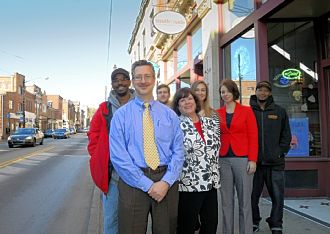
From left, Ron Goings, Rick Belloli, Aaron Sukenik, Judy Dyda, Rachael Glasder, Susie Puskar and DaVar Cutler of the South Side Local Development Co. -- Lake Fong/Post-Gazette
South Side Local Development Co., one of the most successful nonprofit real estate developers in Pittsburgh, will spend the next 18 months putting itself out of business.
The board decided to dissolve the little company whose 28-year tenure on the South Side has coincided with the neighborhood’s transformation in private property values, popularity and market economy.
A successor organization with a focus on public issues will be formed with community feedback to the South Side Planning Forum, the neighborhood’s umbrella for other groups, and the Pittsburgh Partnership for Neighborhood Development.
“This is an exciting transition, and I’m thinking of this as a huge success story,” said Ellen Kight, executive director of the Pittsburgh Partnership for Neighborhood Development. “They have really done what a (community development corporation) is supposed to do.”
Successful development corporations step in with public investment to help neighborhoods attract private investment. Some also have youth and job training programs, public safety committees and other outreach. The South Side nonprofit has largely focused on real estate and has built or renovated more than 100 homes in the past 20 years.
Private developers have added some 800.
“We’ve done our job,” said Tracy Myers, the company’s board president.
In 1982, when the company was founded, property values were two-thirds of the city’s median value, said executive director Rick Belloli. In 2008-09, those values were 170 percent of the city’s median. About 50 percent of the retail space along East Carson Street was vacant in 1982, and that rate is now at about 10 percent, he said.
Rob Stephany, executive director of the Urban Redevelopment Authority, said there is still work to be done by a high-capacity real estate nonprofit in the South Side’s adjacent neighborhoods.
“The target area is big, and the next step would be moving that [real estate] strength to the next frontier,” including Allentown and Arlington, he said.
“Clearly from a real estate value standpoint, the [development company] has been an invaluable piece of the puzzle,” he said. “The equity senior citizens have in their homes is growing, and that’s a proud moment. The fact that there are $400,000 sales in the South Side astounds me to this day.”
The remaining challenges largely have to do with the proliferation of bars, said Ms. Myers. “That’s a consequence of our success.”
The East Carson corridor’s accumulation of liquor licenses is considered to be at saturation by most stakeholders. Uncivil and drunken behavior on weekend nights has some homeowners at the breaking point. Resident Thomas Kolano said he is “very concerned a lot of people are actually talking about leaving the neighborhood.”
“If there isn’t a push-back from residents, this could become an undesirable place to live,” he said. “Sunday through Wednesday and some Thursdays it functions as a normal neighborhood — beautiful and vibrant. I love it. But Friday and Saturday are crazy. It’s like Jekyll and Hyde.”
The city has cracked down on parking violations in recent weeks, and Councilman Bruce Kraus has held several meetings to promote a management strategy for Carson businesses.
Mr. Stephany said a neighborhood improvement district “is an essential next step. The only way to correct some of the issues there is to have collaborative problem solving.”
A neighborhood improvement district is like a business improvement district, except it includes interests beyond those of businesses, such as parks. Participants pay a fee to have the interests of their stated district managed and maintained. The Pittsburgh Downtown Partnership is one example of a business improvement district.
A management strategy for East Carson businesses was recommended several years ago by consultants from the International Downtown Association. A committee of the South Side Planning Forum is gathering feedback to determine the range of focus of the successor organization.
The Pittsburgh Partnership for Neighborhood Development paid for an employee to go door-to-door to gather that feedback. The staff of the local development company will not be involved in the successor agency, although some of its board may be.
Ms. Myers said that while winding down, the agency “still has properties and buildings we want to make sure are well cared for. Some entity needs to keep an eye on these things, to protect all the progress we’ve made to improve the physical environment” and ensure that developers follow historic guidelines.
“Some things we do will have to be done by someone else or not get done,” she said. “The community has to set its priorities.”

